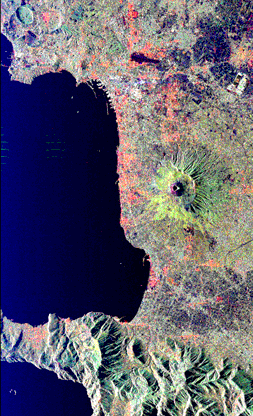
 |
Mt. Vesuvius -- The summit crater and symmetrical shape of Mt. Vesuvius is clearly defined in this SIR-C/X-SAR radar image of the Bay of Naples, Italy. The port city of Naples lies to the northwest of Mt. Vesuvius. This stratovolcano is best known for the eruption that buried the Roman city of Pompeii in 79 AD, located on it's southern flank. The central cone of Vesuvius is surrounded to the north and south by an old crater rim called Mt. Somma. West and slightly north of Naples are a series of large craters that mark the site of a large volcanic zone known as the Phalagrean Fields. Because Mt. Vesuvius has a history of explosive eruptions, and because it lies in close proximity to highly populated areas, it has been designated by the international scientific community as one of fifteen "Decade Volcanoes" which are being intensely studied in the 1990s. Courtesy of JPL/NASA. |